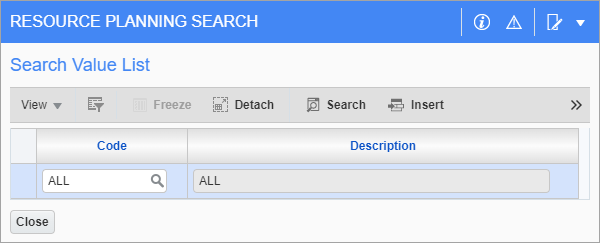Overview
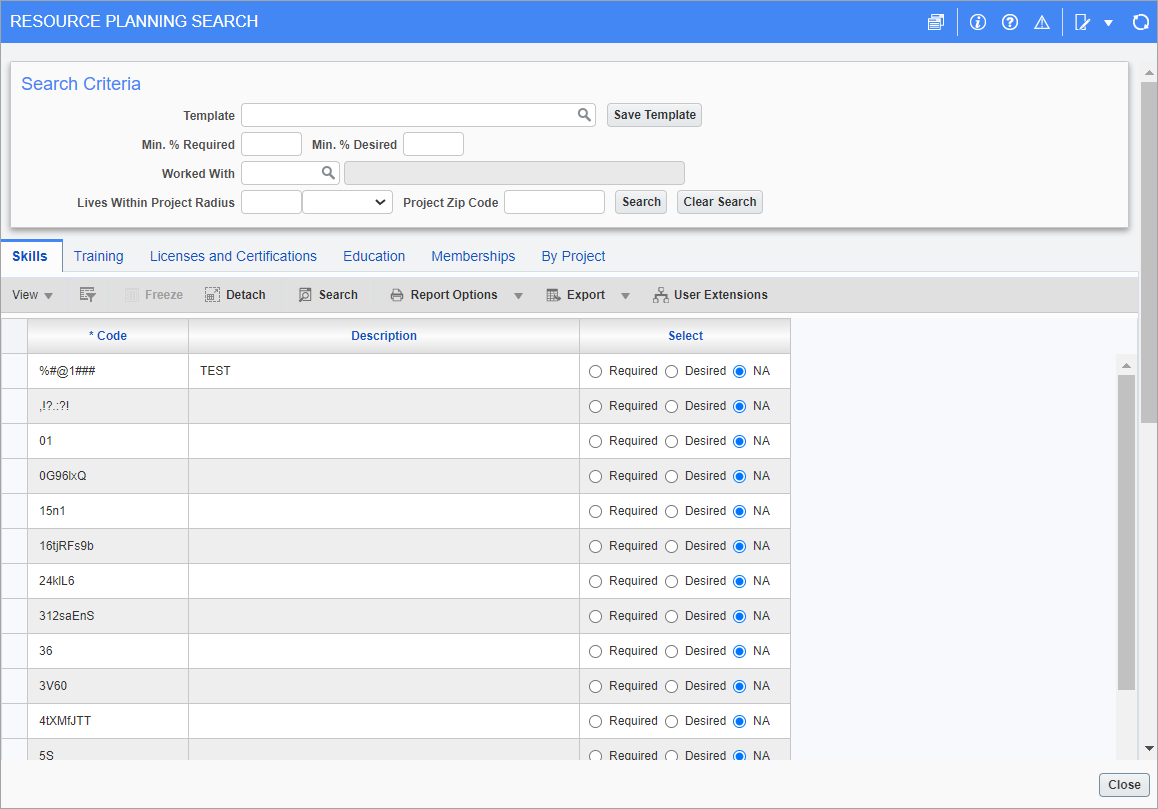
Pgm: RPRESOURCESEARCH - Resource Planning Search; Accessed by the [Search] button on the Resource Planning Detail screen
This screen is used to search for qualified employees from the list displayed under the Resources section of the Resource Planning - Detail - Screen.
This screen searches against a broad range of criteria through the use of a composite search, detailed in the following section.
Search Criteria
Template
This drop-down field is used to load a saved search, saved via the [Save Template] button.
[Save Template] − Button
This button is used to save the composite search, as entered via the fields under the Search Criteria section and via the tabs. This is done by providing a name for the search using the Template field, then saving it via this button. To load the saved search, use the Template field to select it.
Min. % Required, Min. % Desired
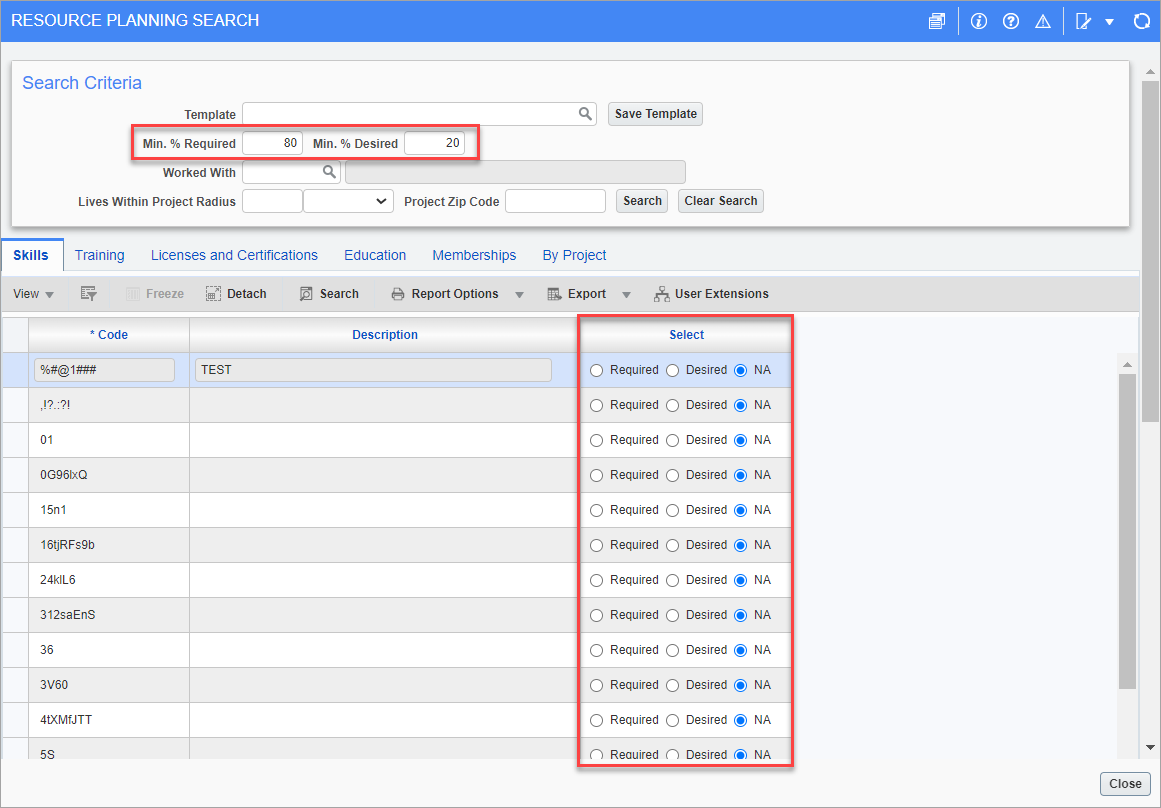
Resource Planning Search screen with the Skills tab selected.
The Resource Planning Search pop-up window can perform two types of searches for qualifications, both of which allow partial matches. It can perform searches for Required and Desired qualifications, and search results are returned and broken down for both types.
As shown above, when selecting the qualifications to search for, either the 'Required' or 'Desired' radio button is selected.
When search results are returned, as shown below, Required % and Desired % values are displayed for each returned employee to indicate what percentage of required and desired HR qualifications were met.
The Min. % Required and Min. % Desired fields are used to filter out the returned results, by specifying minimums for these Required % and Desired % values. As an example, if the Min. % Required and Min. % Desired fields are set to 100%, only full matches will be returned.
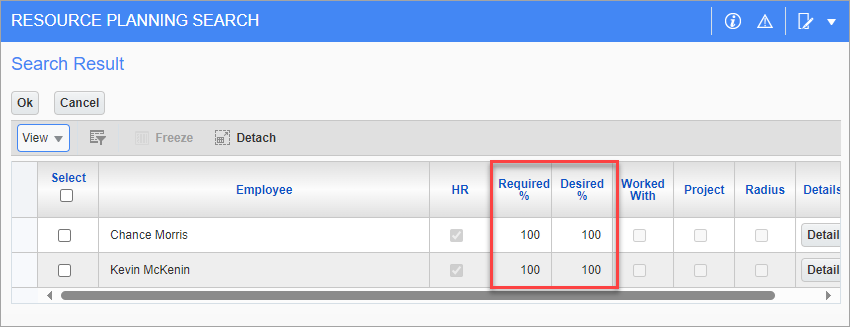
Sample of the Search Result pop-up, listing personnel that satisfied the search parameters.
Worked With
This field is used to search for employees that worked with the selected company or Business Partner.
Lives Within Project Radius, Project Zip Code
These fields are used to search for employees that live within a maximum radius from the project’s location.
For both the employee’s and project’s location, their zip codes (postal code) are used. The Lives Within Project Radius field is used to enter a maximum distance that an employee can live from the project’s location, in order to be returned by the search.
Skills – Tab
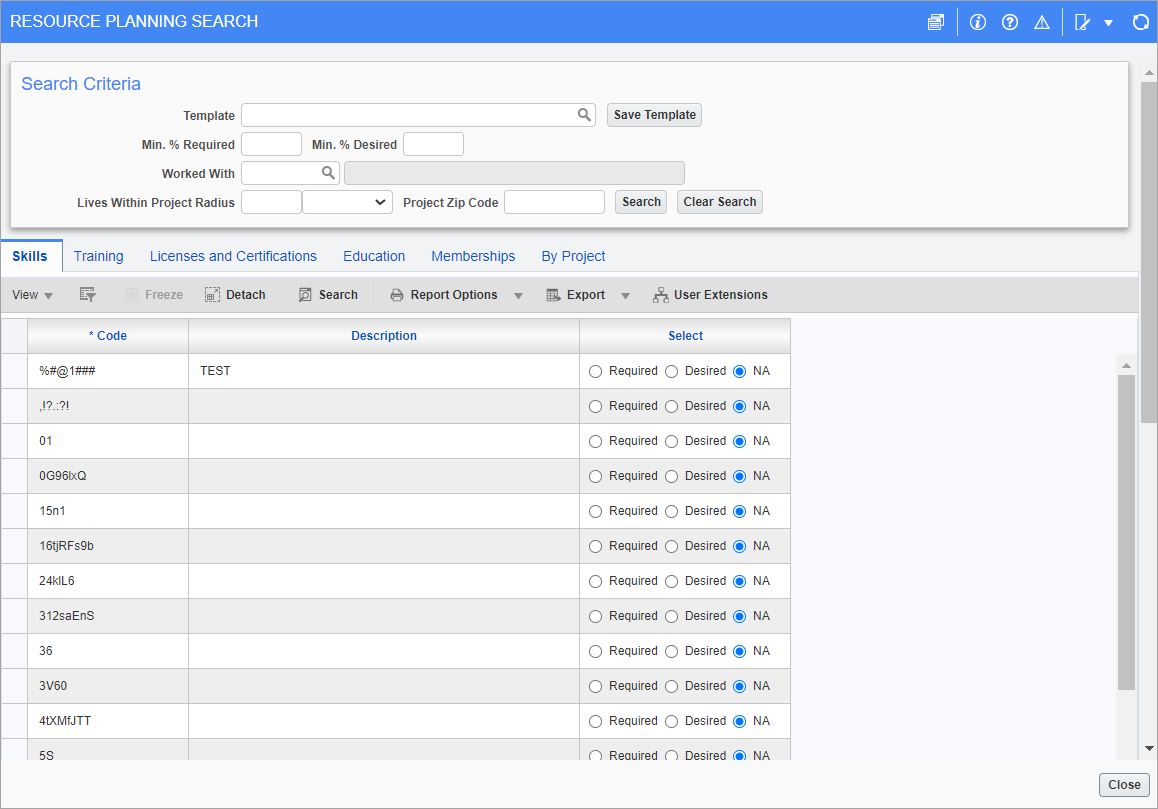
Skills tab on the Resource Planning Search screen.
The Skills tab is used to search for employees with particular skills. The selected skills to search for will be added to the composite search.
The entries to choose from, on this tab, are maintained by the Human Capital Management - Skills screen (standard Treeview path: Human Capital Management > File Maintenance > Skills).
Training – Tab
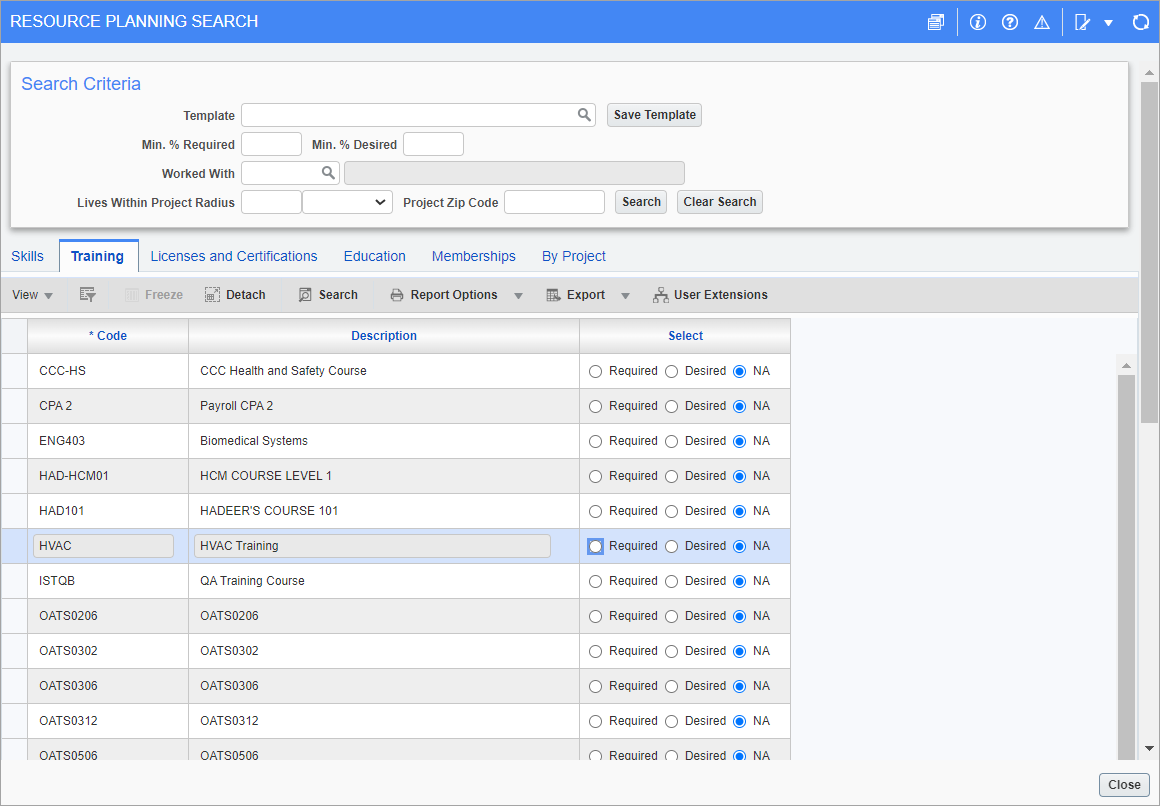
Training tab on Resource Planning Search screen
The Training tab is used to search for employees with particular training. The selected training to search for will be added to the composite search. If the training is required, click the Required radio button, if it is just desired, click the Desired radio button.
The entries to choose from, on this tab, are maintained by the Human Capital Management - Courses and Modules screen (standard Treeview path: Human Capital Management > Training > Courses and Modules).
Licenses and Certifications – Tab
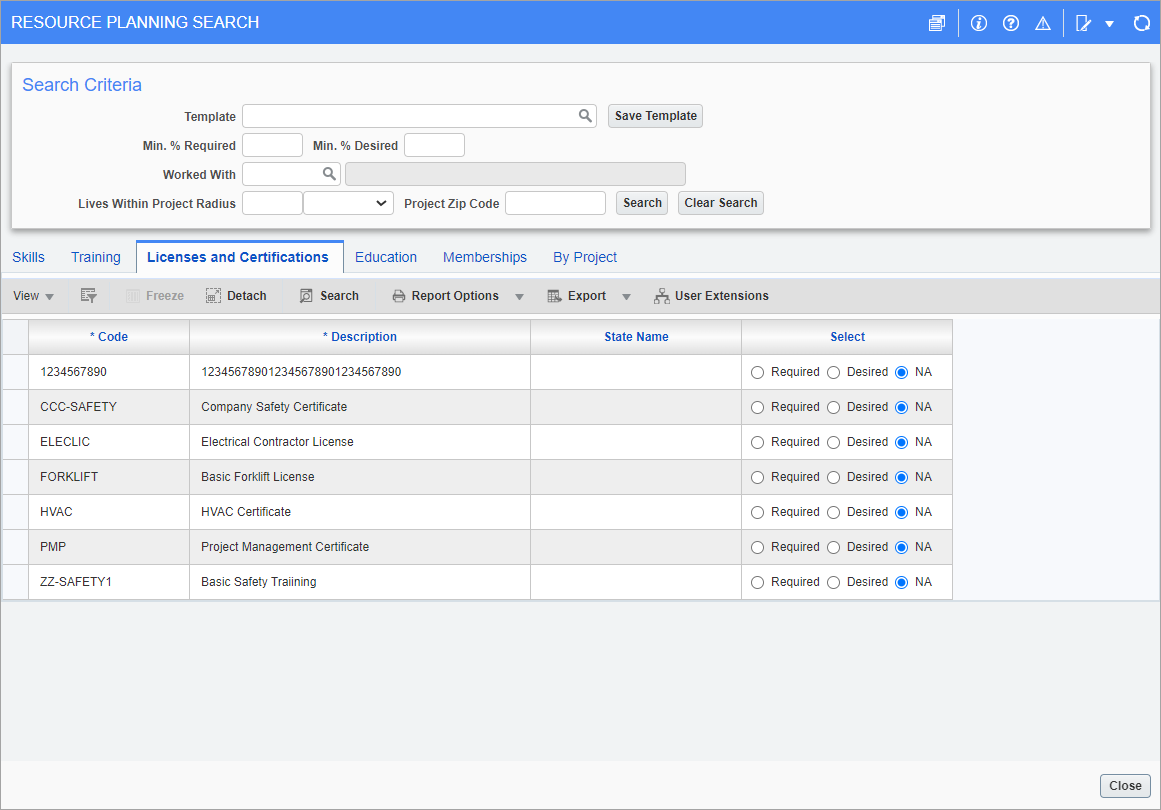
Licenses and Certifications tab on Resource Planning Search screen
This tab is used to search for employees with particular licenses and certifications. The selected licenses and certifications to search for will be added to the composite search.
The entries to choose from are maintained by the Human Capital Management - Certifications and Licenses screen (standard Treeview path: Human Capital Management > File Maintenance > Certification and Licenses).
Education – Tab
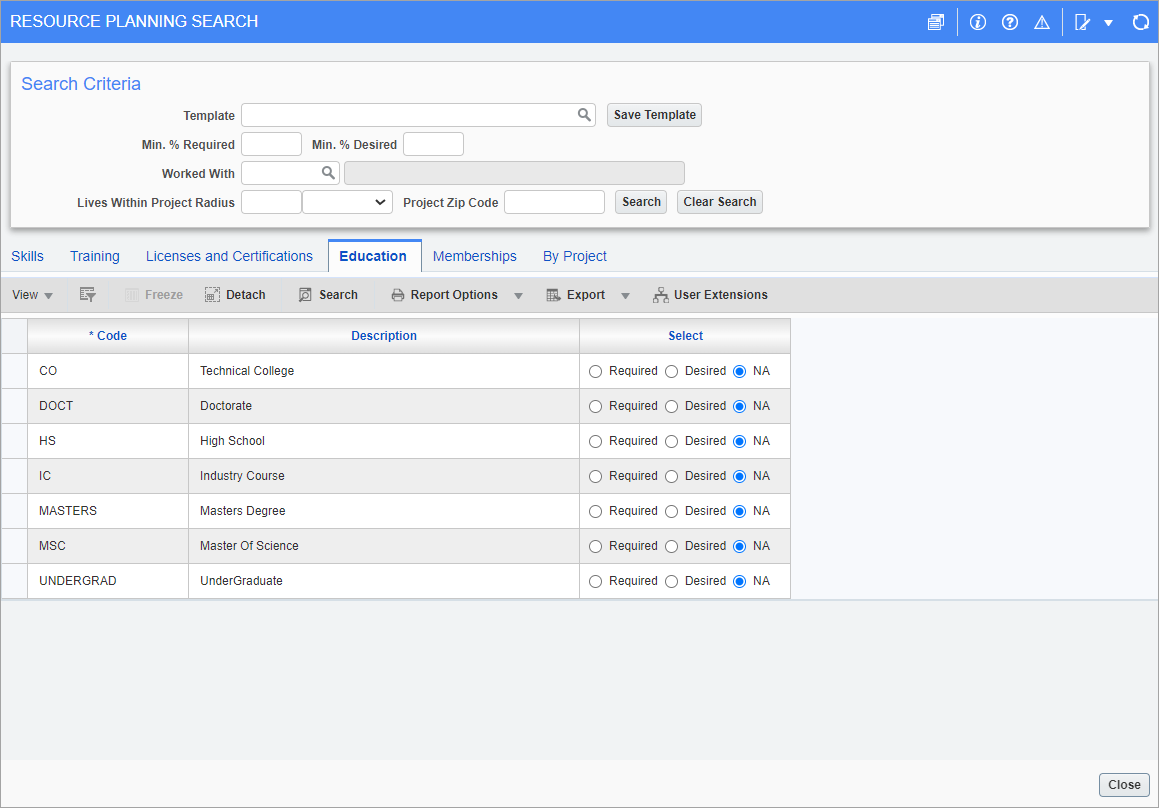
Education tab on Resource Planning Search screen
The Education tab is used to search for employees with a particular education. The selected education to search for will be added to the composite search. If the education is required, click the Required radio button, if it is just desired, click the 'Desired' radio button.
The entries to choose from, on this tab, are maintained by the Education Course Human Resources - Codes screen (standard Treeview path: Human Resources > Setup > Codes > Education Course Codes).
Memberships – Tab
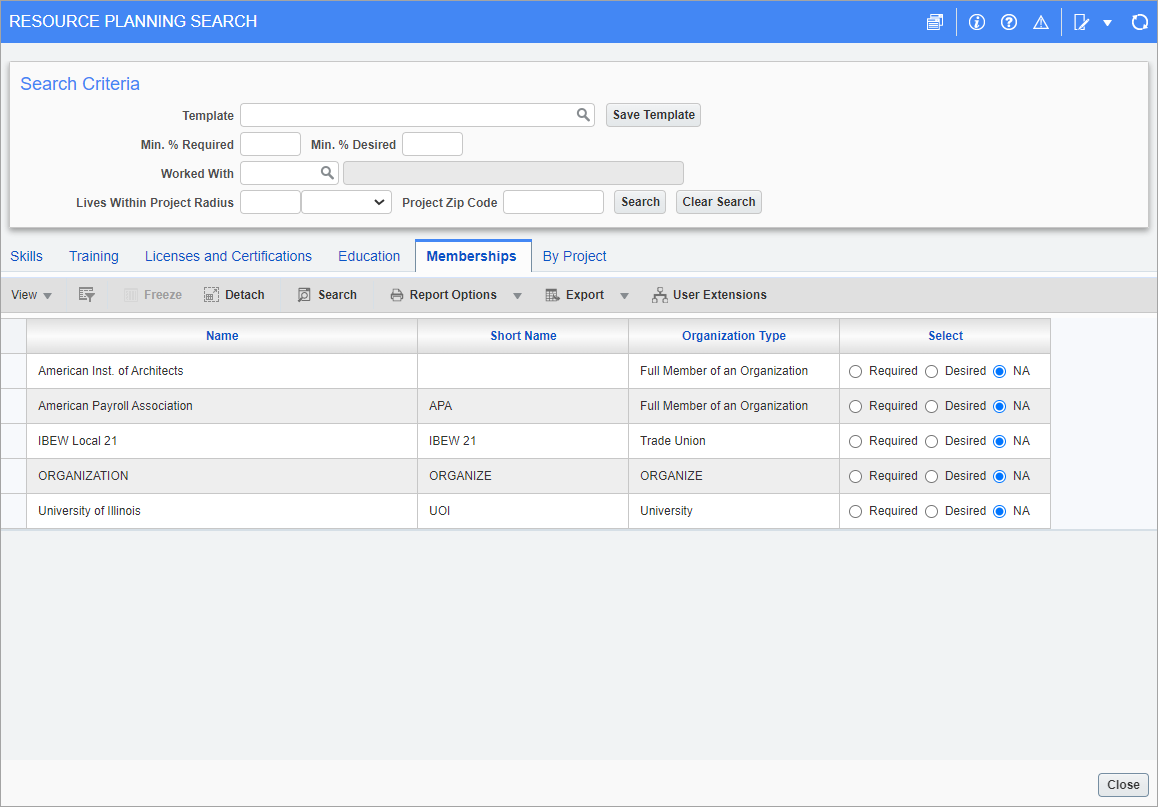
Memberships tab on Resource Planning Search screen
The Memberships tab is used to search for Employees that belong to particular professional organizations/associations. The selected entries to search for will be added to the composite search. If membership is required, click the 'Required' radio button, if it is just desired, click the 'Desired' radio button.
The entries to choose from are maintained by the Organizations screen found in the Human Resources - Local Tables screen (standard Treeview path: Human Resources > Setup > Local Tables > Organizations).
By Project – Tab
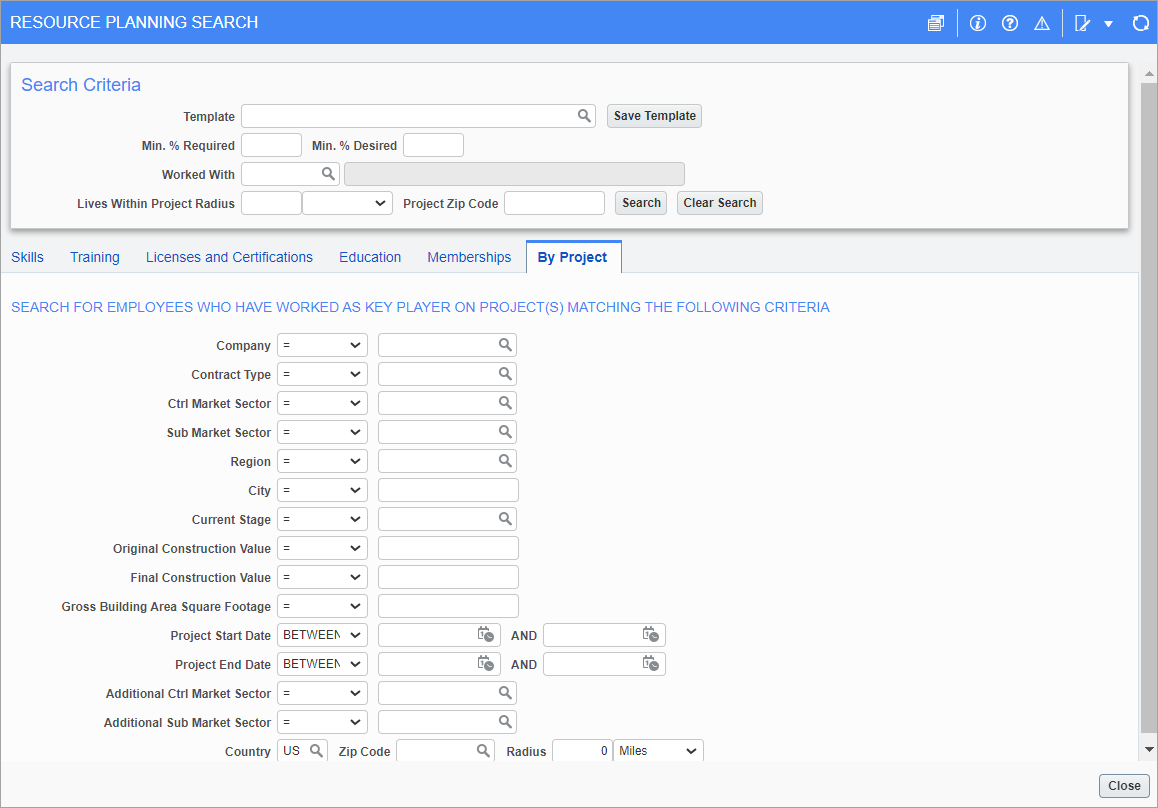
Project tab on Resource Planning Search screen
This tab is used to search for employees that have experience as key players or working on particular types of projects, such as those belonging to a particular market sector.
For details about using the comparison operators and matching conditions (=, IN, NOT IN, BETWEEN) on this screen, please refer to the following subsection.
Composite Search
Resource Planning Search uses a composite search to search for suitable employees, from the list under the Resources section of the Details screen. The composite search is composed of four main components.
Composite Search Components & Search Results
After all of the search parameters have been entered and selected, click the [Search] button to initiate the search.
For an employee to be returned by the search, at least one of the search parameters entered for at least one of the components must be satisfied.
Example
A business partner is selected via the Worked With field, skills are selected on the Skills tab, and certifications are selected on the Licenses and Certifications tab. If an employee has just one of the selected skills, or just one of the selected licenses and certifications, or just satisfies the Worked With field, the employee will be returned by the composite search.
Search 1: Worked With Key Players of Company/Partner
This search component uses the Worked With field in the Search Criteria section.
This search is used to find all of the employees that worked with key players belonging to the company/partner selected via the Worked With field, as members of the same project management team (Key Players Team).
Requirement: Contact Record Linked to Employee Record

Pgm: SYSCNTCT – Contacts; standard Treeview path: Opportunity Management > Contacts - Employee # field must contain Employee’s number, linking Contact record to Employee record.
Members of a Key Players Team can belong to either a company or partner they are associated with rather than employee records. This search returns contact records before those employee records, listed under the Resources section of the Details screen, associated to the returned contact records are returned by this search.
Search 2: Lives Within Project Radius
This search component uses the Lives Within Project Radius field, the corresponding drop-down filed to select the distance unit, and the Project Zip Code field under the Search Criteria section. These fields are used to search for employees that work within the specified distance from the Project’s zip code.
Search 3: Meets HR Qualifications
This search component is used to search for employees with necessary HR qualifications. The Skills, Training, Licenses and Certifications, Education, and Memberships tabs are used to search for these HR qualifications.
As described under the Search Criteria – Section, about the Min. % Required and Min. % Desired fields, there are two types of searches for HR qualifications, both of which allow partial matches.
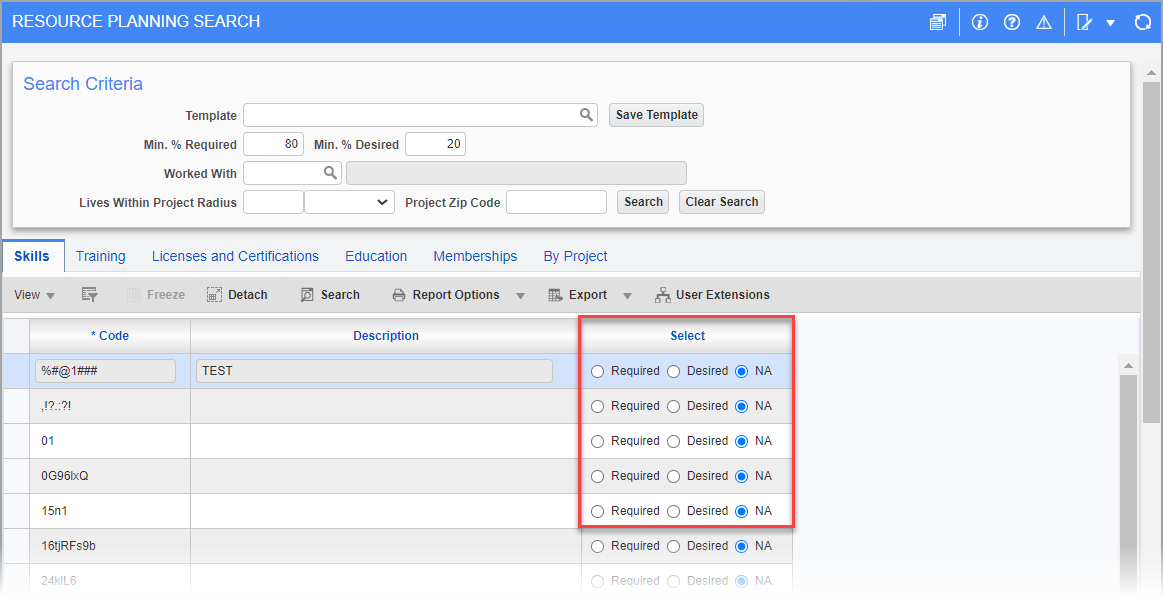
Via the five tabs for each HR qualification type, qualifications to search for are selected by using either the Required or Desired radio buttons, as shown above. NA indicates that the qualification is not searched for.

When search results are returned, as shown above, Required % and Desired % values are displayed for each returned employee to indicate what percentage of required and desired HR qualifications were met.
The Min. % Required and Min. % Desired fields under the Search Criteria section are used to filter out the returned results, by specifying minimums for these Required % and Desired % values.
Method for Calculating Required % & Desired % Values
These Required % and Desired % values are only calculated for HR qualifications.
Part 1
In calculating the Required % and Desired % values for each employee, first, the percentage of required and desired qualifications met is calculated for each of the five HR qualifications (Skills, Training, Licenses and Certifications, Education, and Memberships), including those without any selections (rule for this case below).
No Selection Rule (NSR)
On an HR qualification tab, if no required qualification is selected, then the percentage of required qualifications met for that qualification type is considered to be a 100%, for all employees (none required for that HR qualification type, thus all employees fully meet this requirement). This applies in the same way for desired qualifications. If no desired qualifications are selected for an HR qualification type, all Employees fully meet the desire.
Examples:
Ex. 1) On the Skills tab, 4 required skills are selected and 2 desired skills are selected.
For an employee with 2 of the required skills and with 0 of the desired skills, the percentage of required skills met is 50%, and the percentage of desired skills met is 0%, for this HR qualification type.
These values are used in the second part, when adding up all 5 of the required met percentages, and all 5 of the desired met percentages, to calculate the averages for each.
Ex. 2) No Selection Rule case: on the Memberships tab, no required membership is selected, and 3 desired memberships are selected.
For all Employees, the percentage of required memberships met is 100%, since none was selected; and for an Employee with 1 of the 3 desired memberships met, the percentage of desired memberships met is 33%.
Part 2
For each employee, after the percentages of required and desired qualifications met have been calculated for each of the 5 HR qualification types, the averages of the required and desired qualifications met is calculated. These averages are the final Required % and Desired % values for each Employee, displayed by the search results screen.
Example:
The number of required and desired qualifications selected on each HR qualification tab for this example is provided by the following table, which are used to demonstrate how the final Required % and Desired % values are calculated for each Employee. Note, NSR means it is a case in which the No Selection Rule applies.
|
Skills |
Training |
Lic./Cert. |
Education |
Memberships |
||||||
|---|---|---|---|---|---|---|---|---|---|---|
|
# Selected |
2 req. |
1 des. |
0 req. |
0 des. |
1 req. |
1 des. |
2 req. |
1 des. |
0 reg. |
1 des. |
|
Employee A |
1/2 met 50% |
0/1 met 0% |
NSR 100% |
NSR 100% |
1/1 met 100% |
0/1 met 0% |
1/2 met 50% |
1/1 met 100% |
NSR 100% |
0/1 met 0% |
For Employee A, the final Required % and Desired % values, which are averages, are as follows:
Required % = 50 + 100 + 100 + 50 + 100 = 400, with the average being 400/500 = 80%
Desired % = 0 + 100 + 0 + 100 + 0 = 200, with the average being 200/500 = 40%
The following subsections provide more details about the 5 HR qualification tabs used by this composite search component.
Search 4: By Project
This search component is used to search for Employees who have worked as Key Players on Projects matching the criteria selected on the By Project tab.
Using Comparison Operators & Matching Conditions
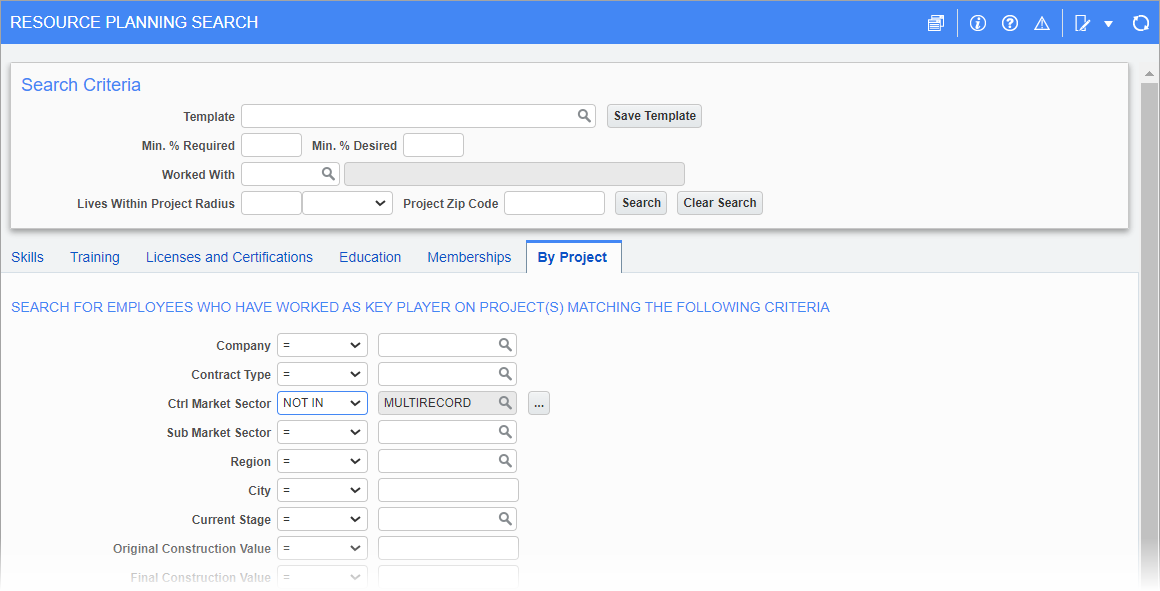
On screens that have search parameters using comparison operators and matching conditions (=, IN, NOT IN, BETWEEN), the first drop-down list is used to select a comparison operator or matching condition, and the second field is used to provide a value for the operator or condition.
Example:
Consider the following search parameter, which uses the NOT IN condition (first parameter) and a list of values to compare against (second parameter):

An opportunity will be returned by this search if its controlling market sector does not match any of the specified values contained in the second drop-down list, which is displayed by the pop-up (shown below) launched by clicking the corresponding  button.
button.
